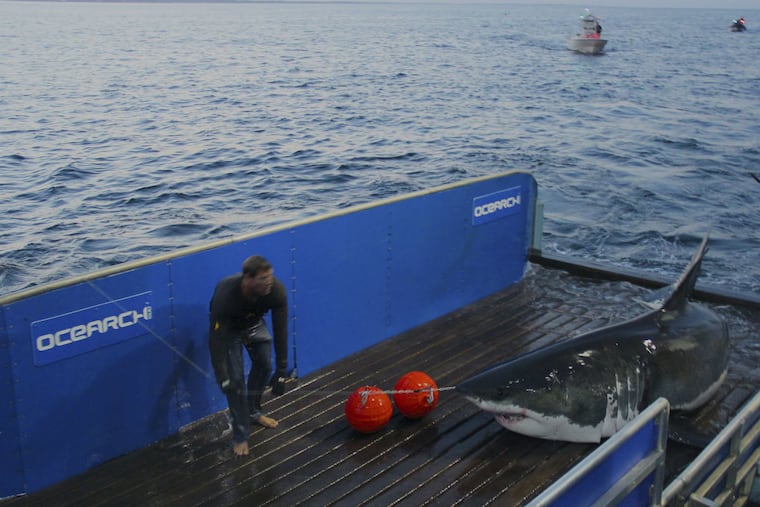Irrational shark fear you can’t escape at the Jersey Shore
Mary Lee was nothing more than coastal cruiser that never drew human blood.

Just about 100 years after the infamous Jersey Shore shark attacks in 1916, Mary Lee showed up.
In 2012, the roughly 3,500-pound, 16-foot Great White was caught in Cape Cod, equipped with a GPS device by the shark research outfit OCEARCH, and released back into the Atlantic. The researchers tracked her all along the East Coast.
Mary Lee quickly went viral. She became an internet sensation when she appeared off the coast of the Jersey Shore in 2015, swimming through Cape May and near Ocean City. She gained about 130,000 Twitter followers on a parody account. That summer, she came within 700 meters of Lavallette and Normandy Beach during one of her sojourns.
She visited the Jersey coast for three straight years. Memorial Day 2017, she was spotted off the coast of Wildwood, and then the coast of Point Pleasant.
The warm response to Mary Lee marked a departure from the sheer terror instilled by a shark with the same iconic gray fin that in the 1970s became a universal symbol of impending doom. Since the 1916 attacks made iconic by the movie Jaws, it's been a rite of Jersey Shore summers for beachgoers to harbor an irrational fear of sharks.
Who knows what the summer of 2018 will bring to the Jersey coast. So far, there was a report last month of a Great White circling near Atlantic City. And over the Fourth of July swimmers were pulled from the water at the Amherst Avenue beach in Ventnor after reports of a sighting in the area.
"[Mary Lee's] become the most famous real shark in history," said Chris Fisher, founder of OCEARCH. "She has shifted the tone. She has undone what Jaws did."
It's Fisher's mission to rid the shoobies and locals in New Jersey of their irrational fear so they can look at the shark's survival as a positive. Mary Lee was nothing more than a coastal cruiser that never drew human blood.
The attacks
Before there was Jaws, a fictional account of a killer shark that terrorized a sleepy beach town, there was reality at the Jersey Shore.
Five attacks, 70 miles apart, in less than two weeks, according to Michael Capuzzo's book Close to Shore: A True Story of Terror in an Age of Innocence. One injured, four killed.
The first attack was in July 1916, in Beach Haven.
Which, coincidentally, is the last place Fisher tracked Mary Lee.
The goal of her GPS-like device, Fisher said, was to collect data on the shark's delicate ecosystem and ensure long-term survival.
"The key is to figure not where they are," Fisher said, "but what they're doing."
Although Great Whites were endangered in the '70s and '80s, conservation has helped fuel a rebound.
Mary Lee is not alone. Jay Pagel, senior field technician for the Marine Mammal Stranding Center in Brigantine, said a Great White sighting was reported recently outside Atlantic City.
"It's that time of year," he said. "They're out there."
These sightings will lead lifeguards to pull swimmers out of the ocean as a precaution.
"The fear of the unknown perpetuates it," Fisher said. "It's an irrational fear that doesn't statistically exist. Far more died taking selfies."
To Fisher, the Great Whites are important to the future — to help solve the puzzle of the food chain.
"When people have data and information and awareness," Fisher said, "those irrational fears fade away."
What happened to Mary Lee?
Mary Lee's GPS-like device was outfitted with a battery equipped for a five-year life span.
Six years after the device was bolted to her fin, the battery died on June 17, 2017.
Where is she now?
Fisher said Mary Lee's tracks follow a predictable migratory loop.
Sharks, like shoobies, tend to circle back to what they know.